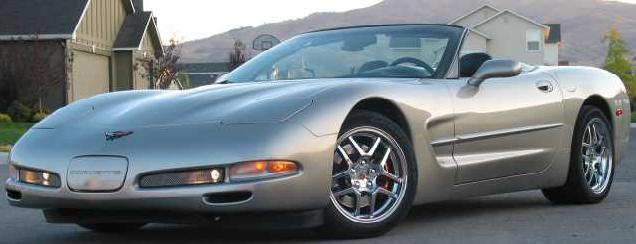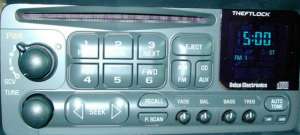|
Introduction
Our
Project Car, the Corvette C5, is equipped with GM's premiere sound system. Its performance is well above your
average car. However, it doesn't begin to compare to the quality aftermarket
systems that are available.

Things to Remember
Here
are a few things to keep in mind when comparing car audio and home audio:
-
Quality:
Just like in home theater, you get what you pay for. Don't expect a
set of $30 speakers to sound good.
-
Off
Axis Response: 99% of the time in the car environment, you are
sitting off axis (unless you drive sitting in the center of the front
seat!), usually 300 - 450. This is something to consider.
Off axis really affects material over 3 kHz, a range that humans are particularly
sensitive to. We will measure and listen to all car audio speakers
both on and
off axis. The high end manufacturers take this off axis into
consideration when designing their equipment.
-
Small
Room Effect: The vehicle is in essence a very small room.
Because of this, the nodes and room gain (lets call it car gain) are
much higher in the frequency band than at home. This also means that
the car gain is very different depending on vehicles. A Lincoln
Navigator has a much different gain than a Honda Civic.
-
Bass
Response: There are many factors to clean bass in the car. In
the home, room resonance is typically very low, whereas it's much
higher in a car. Due to the the air volume restrictions of a car, that
air volume plays a heavier roll in response and loading. Remember that
when in the car, you are actually sitting inside a speaker enclosure.
-
Imaging:
This may be the hardest thing in Car audio. Where do you sit in
relation to the front stage when listening to music? How about 5.1?
The answer is equidistant from the speakers. This is where technology comes to play.
-
Road
Noise: No matter what make, or how expensive the model, you
always have to consider road noise. The C5 exhibits 93 dB at 65mph
(87 dB at idle), with the top up and the windows up. There are ways to
combat road noise, and we will definitely have to address it.
The
C5 Corvette
Head-Unit:
 The
head-unit in the C5 is a Delco CD player with changer control. It has large
buttons and plain styling. The Bose Speaker System here is very odd, as there is a proprietary
connection from the head-unit to each speaker. At each speaker
there is a small amplifier. This makes upgrades of the rest of the system almost
impossible without replacing the head-unit, which for our cause is just
fine. The
head-unit in the C5 is a Delco CD player with changer control. It has large
buttons and plain styling. The Bose Speaker System here is very odd, as there is a proprietary
connection from the head-unit to each speaker. At each speaker
there is a small amplifier. This makes upgrades of the rest of the system almost
impossible without replacing the head-unit, which for our cause is just
fine.
The head-unit supports CD, CD-R, and has changer control for the
factory changer. Note that the changer doesn't fully support CD-R. One
feature that is nice is the SCV (Speed Compensated Volume). SCV raises the
volume as you drive faster, so that the music appears to have a constant
level. Very handy for convertibles.
Amplifiers:
Due to the proprietary connection, there is really no way to bench test
the small Bose amps. There is a single amp in each door powering the 8"
mid-bass. The 3" driver is powered from the deck. The Bose amp appears to
be a class D design. We were able to get about 18 watts out of one of the
amps, measured by voltmeter. However, 18 watts probably isn't the max, as
the measurement was taken during the "best THD at 500hz" test.
Speakers:
Each
door houses an 8" mid-bass and 3" full range (!) driver. The 8"
driver uses an inverted magnet structure to reduce depth. The lack of a
tweeter is very apparent in the system, as the 5 kHz range is very undefined.
The 8" driver goes into heavy distortion on any signal lower than
40 Hz at any meaningful volume. Overall, the system severely lacks punch.
With no tweeter, and running at 15-18 watts per channel, the sound isn't crisp,
and it lacks detail. The mid-bass is muddy, and vocals are harsh.
There
is a low SPL limit to the factory system. The frequency response was taken
at 100 dB. Trying to push past that SPL generated large amounts of ringing
in the THD tests. When you subtract the road noise level from 100 dB you
get a good idea of your system's dynamic range. Now, you can increase that
by going louder, or by making the car quieter. Since I value my hearing,
we are taking the second approach.
Next
Page - The Bench Tests
Terms and
Conditions of Use
![]()
|


 The
head-unit in the C5 is a Delco CD player with changer control. It has large
buttons and plain styling. The Bose Speaker System here is very odd, as there is a proprietary
connection from the head-unit to each speaker. At each speaker
there is a small amplifier. This makes upgrades of the rest of the system almost
impossible without replacing the head-unit, which for our cause is just
fine.
The
head-unit in the C5 is a Delco CD player with changer control. It has large
buttons and plain styling. The Bose Speaker System here is very odd, as there is a proprietary
connection from the head-unit to each speaker. At each speaker
there is a small amplifier. This makes upgrades of the rest of the system almost
impossible without replacing the head-unit, which for our cause is just
fine.

